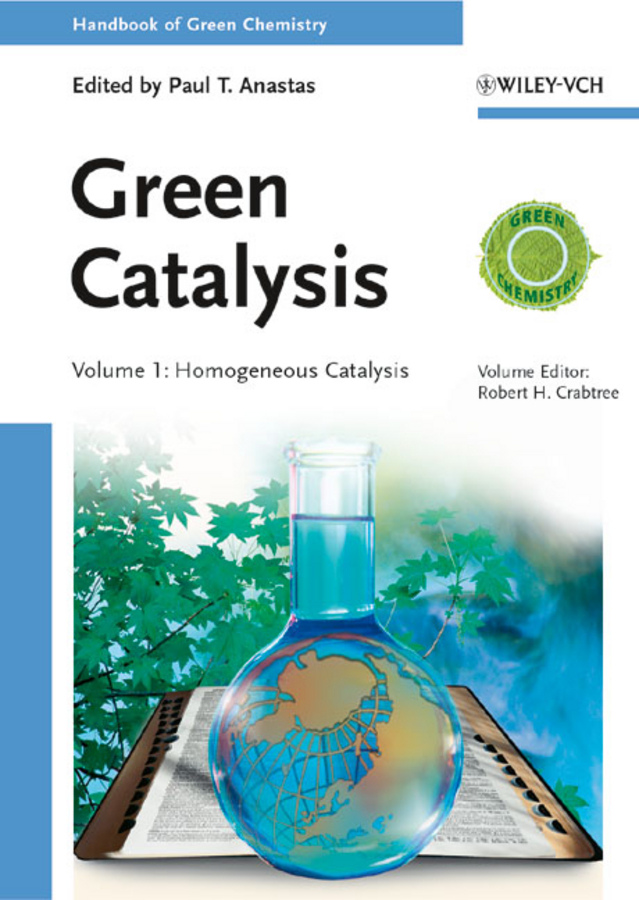
The shift towards being as environmentally–friendly as possible has resulted in the need for this important volume on homogeneous catalysis. Edited by the father and pioneer of Green Chemistry, Professor Paul Anastas, and by the renowned chemist, Professor Robert Crabtree, this volume covers many different aspects, from industrial applications to atom economy. It explains the fundamentals and makes use of everyday examples to elucidate this vitally important field. An essential collection for anyone wishing to gain an understanding of the world of green chemistry, as well as for chemists, environmental agencies and chemical engineers. The Handbook of Green Chemistry comprises of 9 volumes in total, split into 3 subject–specific sets. The three sets are available individually. All 9 volumes are available individually, too. Set I: Green Catalysis – Volume 1: Homogeneous Catalysis – Volume 2: Heterogeneous Catalysis – Volume 3: Biocatalysis Set II: Green Solvents – Volume 4: Supercritical Solvents – Volume 5: Reactions in Water – Volume 6: Ionic Liquids Set III: Green Processes – Volume 7: Green Synthesis – Volume 8: Green Nanoscience – Volume 9: Designing Safer Chemicals The Handbook of Green Chemistry is also available as Online Edition . Podcasts Listen to two podcasts in which Professor Paul Anastas and Journals Editor Paul Trevorrow discuss the origin and expansion of Green Chemistry and give an overview of The Handbook of Green Chemistry . INDICE: About the Editors XIII List of Contributors XV 1 Atom Economy – Principles and Some Examples 1 Audrey Moores 1.1 Introduction 1 1.2 Principle of Atom Economy 2 1.3 Atom Economical by Design: Examples of Reactions Relying on C–H Activation 6 1.4 Conclusion 12 References 13 2 Catalysis Involving Fluorous Phases: Fundamentals and Directions for Greener Methodologies 17 John A. Gladysz 2.1 Introduction 17 2.2 Directions for Greener Fluorous Methodologies 19 2.3 Solvents for Fluorous Chemistry 21 2.4 Ponytails and Partition Coefficients 23 2.5 Specific Examples of Catalyst Recovery that Exploit Temperature–dependent Solubilities 24 2.6 Specific Examples of Catalyst Recovery that Exploit Fluorous Solid Phases 30 2.7 Summary and Perspective 35 References 36 3 Chemistry and Applications of Iron–TAML Catalysts in Green Oxidation Processes Based on Hydrogen Peroxide 39 Terrence J. Collins, Sushil K. Khetan, and Alexander D. Ryabov 3.1 Introduction 39 3.2 Properties of Fe–TAMLs and Mechanisms of Oxidation with Hydrogen Peroxide 40 3.3 Applications of Fe–TAMLs 61 3.4 Conclusion 73 References 74 4 Microwave–Accelerated Homogeneous Catalysis in Water 79 Luke R. Odell and Mats Larhed 4.1 Introduction 79 4.2 Suzuki–Miyaura Reactions 82 4.3 The Stille Reaction 85 4.4 The Hiyama Cross–Coupling Reaction 86 4.5 The Heck Reaction 86 4.6 Carbonylation Reactions 88 4.7 The Sonogashira Reaction 90 4.8 Aryl–Nitrogen Couplings 91 4.9 Aryl–Oxygen Couplings 92 4.10 Miscellaneous Transformations 92 4.11 Conclusion 94 References 95 5 Ionic Liquids and Catalysis: the IFP Biphasic Difasol Process 101 Hélène Olivier–Bourbigou, Frédéric Favre, Alain Forestière, and François Hugues 5.1 Introduction 101 5.2 The Solvent in Catalytic Reactions 102 5.3 The Catalytic Oligomerization of Olefins 104 5.4 The Biphasic Difasol Process 113 5.5 Conclusion 124 References 124 6 Immobilization and Compartmentalization of Homogeneous Catalysts 127 Christian Müller and Dieter Vogt 6.1 Introduction 127 6.2 Soluble Dendrimer–bound Homogeneous Catalysts 128 6.3 Polymer–bound Homogeneous Catalysts 138 6.4 Conclusion and Outlook 149 References 149 7 Industrial Applications of Homogeneous Enantioselective Catalysts 153 Hans–Ulrich Blaser, Garrett Hoge, Benoît Pugin, and Felix Spindler 7.1 Introduction and Scope 153 7.2 Critical Factors for the Technical Application of Homogeneous Enantioselective Catalysts 155 7.3 Industrial Processes: General Comments 157 7.4 Hydrogenation of C¼C Bonds 159 7.5 Hydrogenation of C¼O Bonds 175 7.6 Hydrogenation of C¼N Bonds 181 7.7 Oxidation Processes 183 7.8 Miscellaneous Transformations (Isomerization, Addition Reactions to C¼C, C¼O and C¼N Bonds, Opening of Oxacycles) 188 7.9 Conclusions and Future Developments 195 References 196 8 Hydrogenation for C– C Bond Formation 205 John F. Bower and Michael J. Krische 8.1 By–product–free C–C Coupling and the Departure from Preformed Organometallic Reagents 205 8.2 Hydrogenative Vinylation of Carbonyl Compounds and Imines 210 8.3 Hydrogenative Allylation of Carbonyl Compounds 217 8.4 Hydrogenative Aldol and Mannich Additions 224 8.5 Hydrogenative Acyl Substitution (Reductive Hydroacylation) 233 8.6 Hydrogenative Carbocyclization 236 8.7 Future Directions 240 References 241 9 Organocatalysis 255 Isabelle McCort–Tranchepain, Morgane Petit, and Peter I. Dalko 9.1 Introduction 255 9.2 Catalysts 256 9.3 Reactions 264 9.4 Conclusion 309 References 309 10 Palladacycles in Catalysis 319 Jairton Dupont and Fabricio R. Flores 10.1 Introduction 319 10.2 Catalyst Precursors for C–C and C–X (Heteroatom) Coupling Reactions 320 10.3 Other Catalytic Reactions Catalyzed by Palladacycles 333 10.4 Conclusion 337 References 338 11 Homogeneous Catalyst Design for the Synthesis of Aliphatic Polycarbonates and Polyesters 343 Geoffrey W. Coates and Ryan C. Jeske 11.1 Introduction 343 11.2 Synthesis of Aliphatic Polycarbonates from Epoxides and Carbon Dioxide 344 11.3 Synthesis of Aliphatic Polyesters 360 References 370 12 The Aerobic Oxidation of p–Xylene to Terephthalic acid: a Classic Case of Green Chemistry in Action 375 Walt Partenheimer and Martyn Poliakoff 12.1 Introduction 375 12.2 Methods of Making Terephthalic Acid Using Stoichiometric Reagents 377 12.3 Methods for Preparing Terephthalic Acid Using Cobalt Acetate and Dioxygen in Acetic Acid 378 12.4 Adding Bromide to Improve Terephthalic Acid Production Using Cobalt and Manganese Acetates in Acetic Acid 385 12.5 Potential Processes Using Water as a Solvent 388 12.6 Summary and Final Comments 392 References 394 Index 399
- ISBN: 978-3-527-32496-5
- Editorial: Wiley VCH
- Encuadernacion: Cartoné
- Páginas: 431
- Fecha Publicación: 14/08/2013
- Nº Volúmenes: 1
- Idioma: Inglés
